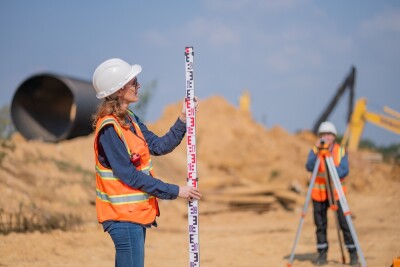As detailed in a recent Geo Week News article, the geospatial industry is “dealing with a shortage of skilled and trained workers.” Professionals in fields like surveying are retiring or on track to retire in the near future, and there is an insufficient pipeline of new talent to replace these individuals or to fill the many new positions the geospatial sector is sure to create as technology evolves and the industry continues to grow.
The April 16 webinar "Mapping the Future: Strategies for Attracting and Developing Geospatial Talent," organized by Geo Week News, looked at this critical shortage of skilled workers. A panel of industry leaders explored the current state of the geospatial workforce and provided insights for companies and organizations on navigating workforce shortages and leveraging data for actionable decisions.
Moderated by Geo Week News Content Specialist Matt Collins, the event featured a panel discussion with Shawana Johnson, CEO, Global Marketing Insights; ASPRS Executive Director Karen Schuckman; Geosearch CEO Jessica Touchard; and Aaron Addison, Executive Director, World Geospatial Industry Council (WGIC). The panelists explained the challenges of finding and retaining top talent for key roles, and they stressed the importance of creating a positive organizational culture and the need to offer attractive employment benefits, including flexible work environments. In addition, the panelists discussed the ways AI and automation could impact recruitment and hiring processes.
Looking at the worldwide geospatial sector, Addison said that the need for skilled professionals varies by region, but overall demand for talent is strong. On any given day, he said, there are between 20,000 and 25,000 job openings in the space, and “that's forecast to basically double in the next five years.”
According to the WGIC’s Addison, European geospatial industry growth is strong, the North American market is growing at rate of 10 – 11% annually, and the Middle Eastern and South American sectors are growing at even faster rates. “On average,” Addison reported, “the industry is growing probably to something over 11%, and that's a pretty conservative estimate.” At the same time, he asserted, “the education pipeline putting talent into the geospatial workforce grows at about 2% over time.” This, Addison said, is a problem that “doesn't get better over the next five years, and probably gets much worse in terms of not meeting the need.”
To address this need, the panelists discussed several approaches. Some focused on better understanding research on the attitudes and priorities of prospective employees. For example, Global Marketing Insights’ Johnson reported on recent survey results revealing that prospective geospatial employees put “salary” high on their list of professional priorities, but “they really like a positive culture and a flexible work environment.” This research, she said, also showed that developers, analysts, consultants, technicians, zoning specialists, and others in the field are interested in working for a company that is on a path to success, offers a collaborative environment, and presents opportunities for travel.
Geosearch’s Touchard reported on her experience working with clients on the hiring process. “What we have seen to be the most successful in terms of the recruitment side is marketing for your organization,” she said. An effort to market a company’s culture and highlight “the projects that you're working on” can be successful. Touchard also looked at retention strategies, including the effectiveness of mentorship programs.
Looking forward, Shuckman from ASPRS suggested that automated decision making may be helpful for recruiters and employees looking to better fill more specific employment gaps. “There might become more and more reliance on automated decision making, automated data processing,” she stated. “As the supply exceeds the demand, I think it might be tempting to have automated systems step in to try to do a lot of the work.”
Register for an on-demand recording of the full webinar here






